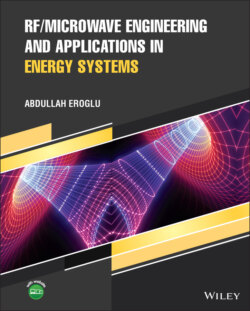Читать книгу RF/Microwave Engineering and Applications in Energy Systems - Abdullah Eroglu - Страница 10
Preface
ОглавлениеRF (radiofrequency)/microwave engineering became a part of our everyday life in this era. Its theory turns ideas into devices that make our life practical. We can now use smart devices that can be used as portable computers, phones, and visual communication tools. It is now possible to drive your car with keyless entry and control the appliances in your kitchen using RF communication. Energy transfer is now possible and gives us the ability to charge our devices wirelessly. It is possible to remotely control vehicles using satellite signals. And there are many more examples of how RF technology has become inseparable from our daily activities.
Although RF/microwave engineering theory and its principles have been widely available in textbooks since the end of World War II, its applications were not commonly used for commercial applications as they are now until students, engineers, and scientists were able to share the information and knowledge around the world using online tools. Furthermore, the advance of semiconductor technology and the implementation of wide‐bandgap semiconductors accelerated the implementation of RF/microwave theory in areas and ways that were not possible before.
The speed of the advance of RF technology means that students require a fundamental knowledge of RF/microwave engineering so that they are well prepared to take part as contributors in this technology. The readiness of students also requires them to be familiar with the applications of RF/microwave theory. Hence, impactful RF/microwave engineering education blends theory and practice. In the RF/microwave world, computer‐aided design (CAD) tools are critically important as they reduce design‐to‐implementation time and cost. Students need to be able to use these tools before they become part of the engineering workforce.
This book is specifically designed to be a unique textbook and resource for senior level undergraduate and introductory graduate level courses in RF/microwave engineering and to meet the needs of instructors and students by providing the fundamental theory for each subject and blending it with real‐world engineering application examples that include design, simulation, and prototyping stages. Each chapter is supplemented with engineering application examples and end‐of‐chapter problems. There are also design challenges that can be assigned by the instructor for students as a project for each topic to implement their analytical skills using CAD tools.
The scope of each chapter in this book can be summarized as follows. Chapter 1 is on the fundamentals of electromagnetics and presents vectors, theorems, and Maxwell's equations. Chapter 2 gives details on passive and active components in microwave engineering. In Chapter 3, transmission lines are discussed and Smith charts are introduced. Network and scattering parameters are covered in Chapter 4. Impedance matching is detailed in Chapter 5. Chapter 6 presents resonator circuits. In Chapter 7, couplers, combiners, and dividers are discussed. RF filter design methods are given in Chapter 8. Waveguides and their theories are given in Chapter 9. In Chapter 10, power amplifier design methods are introduced. Chapter 11 discusses wire antenna and microstrip type antenna design techniques. Chapter 12 presents emerging technologies using RF/microwave engineering principles. Chapter 13 details applications of RF technology in energy systems focused on energy harvesting and heating, ventilation and air conditioning systems.
Overall, the content of this book will enable students to have a better understanding of the theory through real‐world engineering application examples.
Abdullah Eroglu
Greensboro, NC, USA
May 2021
